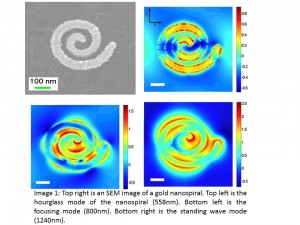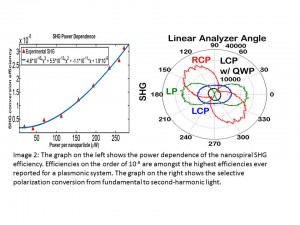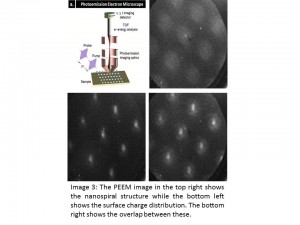Research
 My research focuses on the use of optical nonlinearities in nanoscale structures in order to couple out information about the near-field electrodynamics of the system. These structures have so far ranged from plasmonic systems to thin films of semiconductors and oxides.
My research focuses on the use of optical nonlinearities in nanoscale structures in order to couple out information about the near-field electrodynamics of the system. These structures have so far ranged from plasmonic systems to thin films of semiconductors and oxides.
The Nanospiral
The first major breakthrough in my research at Vanderbilt was demonstrating the Archimedean plasmonic nanospiral as an efficient generator of second harmonic light as well as a unique optically chiral element. You can see SEM images as well as calculated surface charge distributions in Image 1. Image 2 shows the SHG measurements as well as the selective polarization conversions. This polarization conversion demonstrates the chirality of the plasmonic element. These measurements were made using a transform limited 800nm pulse with a duration of 20fs. This means that the surface mode that is responsible for these nonlinear properties is the focusing mode.
This polarization conversion demonstrates the chirality of the plasmonic element. These measurements were made using a transform limited 800nm pulse with a duration of 20fs. This means that the surface mode that is responsible for these nonlinear properties is the focusing mode.
Since the plasmon resonances of the nanospiral had only been calculated up to this point, we used photo-emission electron microscopy (PEEM) with the help of Wayne Hess and Yu Gong at Pacific Northwest National Laboratory. Image 3 shows the PEEM images taken using a neon lamp and a 800nm ultrafast excitation source. These PEEM measurements have the major advantage of not perturbing the structure of the resonance like some traditional near-field observation techniques would such as near-field scanning optical microscopy (NSOM).
These PEEM measurements have the major advantage of not perturbing the structure of the resonance like some traditional near-field observation techniques would such as near-field scanning optical microscopy (NSOM).
The future of this project lies in utilizing the strong nonlinearities of this plasmonic system to create interference distributions between spectrally separate modes.
My current research continues the theme of coupling out near-field electrodynamics of nanoscale systems using nonlinear optical phenomenon, specifically SHG.
Connect with Vanderbilt
©2025 Vanderbilt University ·
Site Development: University Web Communications